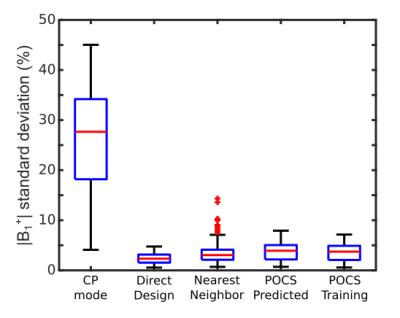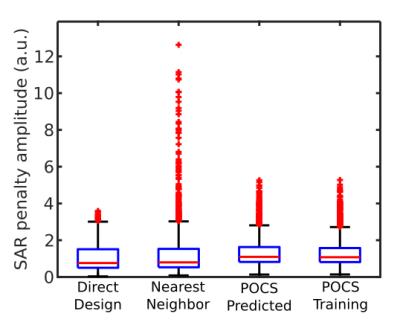3992
SAR-Efficient RF Shim Prediction via Machine Learning1Department of Biomedical Engineering, Vanderbilt University, Nashville, TN, United States, 2Vanderbilt University Institute of Imaging Science, Vanderbilt University, Nashville, TN, United States, 3Department of Radiology, Vanderbilt University, Nashville, TN, United States, 4Department of Electrical Engineering, Vanderbilt University, Nashville, TN, United States
Synopsis
A method is presented for prediction of patient-tailored, SAR-efficient RF shims via machine learning. An iterative training scheme allows fast prediction of SAR-efficient shims for new head phantoms using little B1+ map data.
Purpose
The purpose of this work is to design a machine learning framework to enable instantaneous prediction of patient-tailored radiofrequency (RF) shims for magnetic resonance imaging at high field, where the uniformity of transmit RF fields degrades with increasing field strength. Patient-tailored RF shim design for parallel transmission can compensate for this non-uniformity.1,2 However, finding an adequate solution to the associated magnitude least squares (MLS) optimization problem requires measurement of patient transmit field (B1+) maps for each coil, which takes on the order of minutes for a large number of coils, even with the fastest mapping sequences. The solution must meet RF amplitude and power constraints, as well as specific absorption rate (SAR) constraints; the resulting non-convexity (due to MLS) translates to long compute times and difficulty in robustly finding a globally optimal shim.3 Prediction of RF shim weights would require minimal B1+ mapping and negligible online compute time to obtain tailored RF shims. Here, a method is presented for RF shim prediction using machine learning of SAR-efficient patient-tailored RF shims.
Methods
A 50-subject 3D in silico phantom dataset of B1 maps was generated via simulation of a 24-channel coil in XFDTD (Remcom Inc., State College, PA, USA). Models were from the Virtual Family4 with variation in 3-dimensional magnification according to a population-based normal distribution.5 The resolution of the simulated maps was 5mm isotropic. A variable-exchange magnitude least squares method3,6 with 100 random initializations was used to design shims for 31 slices for each subject (Direct design). Predictions were made using linear ridge regression trained via a projection over convex sets (POCS), in which training solutions were iteratively projected onto the set predictable by linear ridge regression of the features. Features for prediction included a single central Fourier coefficient of each coil's B1+ map, the mask centroid, standard deviations of the within-mask x and y coordinates, slice z-position, and 1st-order cross-terms of these features. A 10-fold cross-validation was performed across all slices. Training and direct shim optimization were penalized by a SAR regularization term calculated from Virtual Observation Points (VOPs).7 Shims were predicted for slices in the test set by a linear projection of their features with weights derived from the POCS training set shims. Shims chosen from each test slice's nearest neighbor (NN) in terms of features, as well as the circularly polarized (CP) mode shims were also calculated for comparison.Results
Excitation profiles for the predicted RF shims are shown in Figure 1 for the best-, median- and worst-case slices, and are compared to CP mode shims, directly designed shims (the best of the 100 random starts in each slice), NN shims, and to those from the POCS ridge regression shim design of the training set shims. Figure 2 shows box plots of the standard deviation of |B1+| as a percentage. Predicted RF shims performed comparably to the training-set shims in achieving uniform flip angle patterns for all test slices, with median |B1+| standard deviations of 6.0% and 5.9%, respectively, compared to 2.3% for directly designed shims. Figure 3 shows boxplots of the final SAR-regularization penalty for directly designed, nearest neighbor, predicted, and training shims. Predicted shims demonstrate SAR-efficiency comparable to training shims and directly designed shims, outperforming NN shims.Discussion
Predicted shims produced homogeneous excitation patterns (Figs. 1,2) and are similarly SAR-efficient to those directly tailored for an individual subject and slice (Fig. 3). The prediction requires only the central Fourier-coefficient from each coil's B1 map for a single slice, which has the potential to save significant B1-mapping time at the scanner. It is further possible that mapping some coils could be skipped altogether. Due to the non-convex nature of the MLS problem, potential shim solutions are diverse and difficult to interpolate across, causing direct application of conventional machine learning methods to fail; iteratively re-designing training-set shims via the POCS method enables a prediction which interpolates over shim solutions. Though NN does not interpolate over shim solutions and achieved an adequate shim in many cases, the POCS predictions were more homogenous and more SAR efficent. While it is applied to SAR-efficient RF shim design in particular here, this POCS-trained machine learning is a general framework which may incorporate additional regularizations (e.g. power, amplitude), constraints, or target pulses.Conclusion
SAR-efficient RF shims predicted by machine learning can save time at the scanner, both in scan time and compute time, particularly as field strengths and coil numbers increase. SAR-efficient shim prediction is a potentially enabling step in fast and safe patient-tailored MRI at high field.Acknowledgements
This work was supported by NIH grant R01 EB016695.References
1) Ibrahim, T. et al. MRI 19:1339-1347 (2001) 2) Mao, W. et al, MRM 56:918-922 (2006) 3) Hoyos-Idrobo, A. et al, IEEE TMI 33:739-748 (2014) 4) Christ, A. et al., Phys Med Biol 2010 5) Young, J. U.S. FAA, No. DOT/FAA/AM-93/10, (1993) 6)Setsompop, K. et al, MRM 59:908-915 (2008) 7) Eichfelder, G. et al., MRM 66:1468-1476 (2011)Figures


